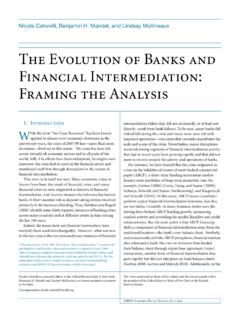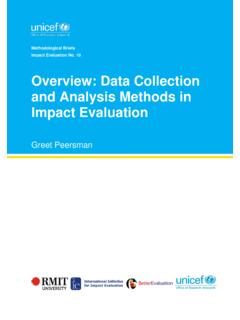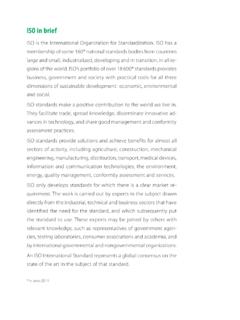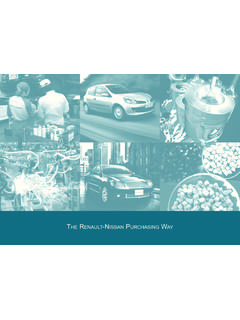Transcription of The Aqua Book
1 The Aqua Book: guidance on producing quality analysis for government March 2015. The Aqua Book: guidance on producing quality analysis for government March 2015. Crown copyright 2015. This publication is licensed under the terms of the Open Government Licence except where otherwise stated. To view this licence, visit or write to the Information policy Team, The National Archives, Kew, London TW9 4DU, or email: Where we have identified any third party copyright information you will need to obtain permission from the copyright holders concerned. This publication is available at Any enquiries regarding this publication should be sent to us at ISBN 978-1-910337-67-7. PU1740. Contents Page Foreword 3. Chapter 1 Introduction 5. Chapter 2 Decision-making and analysis 13. Chapter 3 Commissioning analysis 21. Chapter 4 Quality analysis and quality assurance 23. Chapter 5 The importance and implications of uncertainty 29.
2 Chapter 6 Verification and validation 35. Chapter 7 Analytical assurance 47. Chapter 8 Analysing uncertainty 49. Chapter 9 Aqua Book resources 61. Chapter 10 Acknowledgements 63. 1. Foreword analysis and the use of evidence informs every decision we make as civil servants. It also underpins the civil service values of integrity, honesty, objectivity and impartiality by which we are held to account. The breadth of topics on which the civil service provides advice is extraordinary from the health of the public finances to predicting the spread of pandemic flu, from forecasting our future energy needs to the complex commercial decisions that underpin our infrastructure ambitions. High quality analysis is therefore fundamental to the civil service's effectiveness. I see high quality analysis all the time as I look at the complex and varied issues with which civil servants grapple. But since the difficulties with the Intercity West Coast franchise competition, the quality of our analysis has, rightly, been scrutinised.
3 In October 2012, I was commissioned to review the quality assurance of analytical models across government. The recommendations of that review were written with the aim to extend best practice across the whole of government. They focus on quality assurance, governance and accountability, culture, capacity, capability and control. Continuous challenge and improvement is essential to ensure that the people we serve . ministers and, of course, the public have trust in our analysis . Following the Review of quality assurance of government analytical models, a cross-departmental working group on analytical quality assurance was established. The Aqua Book is one of the products this group has developed. It outlines a sensible, achievable set of principles. These principles will help ensure that our work can be trusted to inform good decision making. I'm grateful to all those who contributed to it. As the Aqua Book points out, we need to create an environment where the skills and time to deliver analysis is respected, and a culture that values it is encouraged.
4 I commend it to you. Nick Macpherson Permanent Secretary to the Treasury 3. 1 Introduction Fit-for-purpose analysis in government analysis is vital to the success of policy development and the delivery of programmes, projects and operational services. analysis helps to shape and appraise options, provides insight into how complex systems work and behave, measures system performance and improves efficiency. However, if analysis and any supporting models, data and assumptions are not fit-for- purpose then the consequences can be severe ranging from financial loss through to reputational damage and legal challenge. In the most severe of consequences, lives and livelihoods can be affected. The InterCity West Coast franchise competition of 2012 illustrated both the importance of analysis and modelling in delivering a major government project and the consequences when things go wrong. The subsequent Review of quality assurance of government analytical models1.
5 Found significant variation in the type and nature of quality assurance used within, and between, departments. Much of this was to be expected given the differences in organisations'. remits, and the levels of risk in question. The review's work highlighted the benefits of creating a work environment that expects thorough quality assurance including allocating clear responsibility for key models and how they are used, and giving specialist staff adequate time to manage quality assurance effectively. The review provided headline recommendations for departments and their arm's length bodies, including: All business critical models in government should have appropriate quality assurance of their inputs, methodology and outputs in the context of the risks their use represents. If unavoidable time constraints prevent this happening then this should be explicitly acknowledged and reported;. All business critical models in government should be managed within a framework that ensures appropriately specialist staff are responsible for developing and using the models as well as quality assurance.
6 There should be a single Senior Responsible Owner for each model ( a Model SRO ). through its lifecycle, and clarification from the outset on how quality assurance is to be managed. Key submissions using results from the model should summarise the quality assurance that has been undertaken, including the extent of expert scrutiny and challenge. They should also confirm that the Model SRO is content that the quality assurance process is compliant and appropriate, that model risks, limitations and major assumptions are understood by users of the model, and the use of the model output is appropriate. The review found that the many components of best practice in quality assurance fall under 2 headings: the modelling environment, which can be generalised to cover the wider environment in which analysis takes place, and process. The right modelling environment involves a culture where leaders value and recognise good quality assurance.
7 It requires adequate capacity, including specialist skills and sufficient time to 1. Review of quality assurance of government models, , Accessed February 2015. 5. conduct quality assurance effectively. It also needs a set of controls, including a clear internal chain of responsibility and a route for challenge where analysts have concerns The process side, on the other hand, is about a systematic approach to make quality assurance accessible, easy and comprehensive. It requires clear guidance on quality assurance and clear documentation for every model. Quality principles Following the review, the cross-government working group on analytical quality assurance was established to identify and share best practice across government. The Aqua Book is one of the products this group has developed. It draws together existing practice from departments and best practice from analysts across a variety of analytical professions within government.
8 The Aqua Book builds upon the Review of quality assurance of government analytical models and expands the principles to cover all types of analysis as there is much common ground. The Aqua Book sits underneath the Review of quality assurance of government analytical models as supporting material to help those implementing the review's recommendations and more generally to promote analytical quality. It should be read in this context: as providing further advice rather than making specific or binding recommendations. No single piece of guidance can provide a route to a definitive assessment of whether a piece of analysis is of sufficient quality for an intended purpose. However, the Aqua Book sets out the following principles of analytical quality assurance that will help to support commissioning and delivery of fit-for-purpose analysis : Proportionality of response: The extent of the analytical quality assurance effort should be proportionate in response to the risks associated with the intended use of the analysis .
9 These risks include financial, legal, operational and reputational impacts. In addition, analysis that is frequently used to support a decision-making process may require a more comprehensive analytical quality assurance response. Assurance throughout development: Quality assurance considerations should be taken into account throughout the life cycle of the analysis and not just at the end. Effective communication is crucial when understanding the problem, designing the analytical approach, conducting the analysis and relaying the outputs. Verification and validation: Analytical quality assurance is more than checking that the analysis is error-free and satisfies its specification (verification). It must also include checks that the analysis is appropriate, fit for the purpose for which it is being used (validation). analysis with RIGOUR: Quality analysis needs to be repeatable, independent, grounded in reality, objective, have understood and managed uncertainty, and the results should address the initial question robustly.
10 In particular, it is important to accept that uncertainty is inherent within the inputs and outputs of any piece of analysis . It is important to establish how much we can rely upon the analysis for a given problem. Accountability Following the Review of quality assurance of government analytical models, all business critical government models should have a single model Senior Responsible Officer ( a Model SRO ) through their lifecycle. The key prerequisites are that this should be a named individual 6. with sufficient seniority to take responsibility for the model throughout its life cycle and sign-off that it is fit-for-purpose, prior to its use. This principle can be generalised to cover any business critical analysis and there may be a need for interaction between a model SRO and those responsible for a wider analytical project to ensure that quality assurance considerations are fit-for-purpose and are appropriately communicated.

















